Some years ago Kondô Hôji (近藤邦治), the president of the Gifu branch of the NBTHK, discovered a transcription of a sword publication published in Bunka three (文化, 1806). Well, the sword publication itself is rather diversified and covers the usual spectrum, and the reference to the second year of Gentoku (元徳, 1330) as time of the publication of the original is highly questionable. It is assumed that this is a typo and that either Genroku (元禄, 1688-1704) or Shôtoku (正徳, 1711-1716) was meant. However, this transcription contains an interesting chapter called „Menuki-ana no shidai“ (目貫穴之次第, about „The Conditions of menuki-ana“), yes menuki-ana, but actually mekugi-ana are meant. The book depicts 15 illustrations of different mekugi-ana which are introduced in the following by adding as far as possible similar mekugi-ana on actual blades.
The first three pictures describe an arrangement of two or three peg holes one below the other or in a triangle. These arrangements are called „futatsu-momi“ (フタツモミ) and „mitsu-momi“ (ミツモミ) respectively what might best be translated as „twosome rubbing“ and „threesome rubbing“. The text mentions that in this category, just the number is counted and that four aligned menuki are called „yotsu-momi“ (ヨツモミ) and five „itsutsu-momi“ (イツツモミ) and so on. A mitsu-momi in a triangular arrangement is very rare and is mostly restricted to early kotô blades like the one shown below from a tachi of Bungo Yukihira (行平).
The fourth picture is called „urizane“ (ウリサ子, lit. „melon seed“). So here not the arrangement but the shape of the mekug-ana is described. Such a hole is very common and comes by widening an existing mekugi-ana. The picture to the left shows an actual example on a tantô of Tomoyuki (友行).
Picture number five is called „nasu-hisago“ (ナスヒサ子, lit. „eggplant“). Such a mekugi-ana is rather rare and is found, if at all, mostly on kotô-tantô as the example on a blade by Morimitsu (盛光) shows. A nasu-hisago hole is in the same way a widened mekugi-ana as the urizane hole.
Number six is called „tsutsumigane“ (ツゝミカ子) what refers to the shape of a wrapped-up money present (tsutsumigane, 包み金) or the auspicious symbolism of a bag of gold (kanabukoro, 金袋, see b/w picture in the middle). Principally a tsutsumigame describes a hole which was once widened and where the mekugi got loose again. To tighten the peg, the steel was hammered from one side to narrow the hole again, namely to avoid opening a new mekugi-ana. The picture to the right shows an actual tsutsumigane hole on a tachi of Shikkake Norinaga (尻懸則長).
The seventh picture bears the name „kurahone“ (クラホ子), i.e. the frame (hone, 骨) of a wooden saddle (kura, 鞍). It is hard to find actual examples of mekugi-ana which match this depiction but probably one like seen on the tachi of Hisakuni (久国) on the right is meant.
The name of the mekugi-ana in picture eight is again more clear, namely „hyôtan“ (ヒヤウタン, „bottlegourd“). Such a hole is quite often found and the result of two differently sized mekugi-ana opened so close that their merge into each other. The picture on the right shows a hyôtan-mekugi-ana on a wakizashi of Taikei Naotane (大慶直胤).
Number nine is called „yomitori“ (ヨミトリ). The verb „yomitoru“ (読み取る) means „to read (from an instrument for example)“, „to read into“, or „to read (someones) mind“. But because of the transcription in katakana syllables it is unclear if really this verb is meant. Such a mekugi-ana is very hard to find on actual blades and it might be assumed that it was actually a hidden Christian symbol.?
Most collectors are probably familiar with the term in the next, the tenth depiction, which is namely „suhama-gata“ (スハマカタ), i.e. it refers to the suhama (洲浜) element as we know it for example from hitsu-ana on tsuba. Such mekugi-ana are most likely found on wide kotô-era sunnobi-tantô as demonstrated by the blade of Unjû (雲重) shown on the right.
Number eleven and twelve are called „ko-masugata“ (小マスカタ) and „ô-masugata“ (大マスカタ) respectively, i.e. small (ko, 小) and large (ô, 大) square masugata, 枡形). However, it is unclear how it was actually distinguished between „small“ and „large“. Kondô suggests that if the edge of a square mekugi-ana corresponda approximately to the diameter of an average mekugi-ana, it might be called as ko-masugata. If the edge is larger, probably the classification ô-masugata applies. To substantiate this approach, we see at the lower left a tachi of Ôhara Sanemori (大原真守) where the square hole has about the same size as the regular mekugi-ana. At the Taima-tantô (当麻) to the right, the square hole is a hint larger as the regular mekugi-ana. By the way, such a hole is quite archaic and goes back to times when menuki and mekugi formed a unit and where the square hole hindred the ornament from twisting.
Also the name of picture number 13 is familiar as it is called „inome“ (イノメ). It occurs when a mekugi-ana is opened in an overlapping manner right next to an existing mekugi-ana. As example serves a tantô of Hoshô Sadayoshi (保昌貞吉).
The last two depictions of the chapter „Menuki-ana no shidai“ are both called „hangetsu“ (ハンケツ, „half-moon“) whereas the the last one to the right reminds more of a comma-shaped bead (magatama, 勾玉) oder of a tomoe (巴). And the former one seems to be exaggerated as it is hardly possible to stick a mekugi through such an opening. So maybe the last two examples actually don´t show mekugi-ana but shapes which occur through an orikaeshi-mei or gaku-mei (see picture at the lower left on a katana of Kunimune, 国宗), or a semegane softmetal fitting (see picture at the lower right on a katana of Sukesada, 祐定). In this sense it is possible, that the katakana syllables „hanketsu“ actually stand for (半欠) what means „half missing“.
All those mekugi-ana go back to the necessity of adding a new peg hole or to enlarge or adjust an existing one. That means except maybe number nine with the cross-shape, we are probably not dealing with holes which were consciously opened in suhama or inome shape and the like. In other words, the publication just gathered existing mekugi-ana and gave them names. In earlier times, smiths or other craftsmen were not exactly gentle when it came to adding new holes as they were drilled through signatures and dates without remorse. Today this seems like „wanton destruction“ of important references but back then a new peg hole just marked a new phase in the life of a blade as the owner was at the best a „custodian“ who took the sword temporarily from his predecessor and had to give it away at the end of his life.
When with the Edo-period and especially with the emergence of the Ôsaka-shintô schools meticulous and elabotate nakago finishes came into fashion and even emphasis was laid on the calligraphic value of a signature, the peg hole could not just be left out and placed randomly. That means many smiths decided where the first and original ubu-ana (生ぶ孔) was positioned, mostly also in relation to the signature. A lateral trend in the attention to peg holes were the so-called „keshô-ana“ (化粧孔, lit. „ornamental holes“). An example of a keshô-ana is the tsubo-ana (坩孔, lit. „pot-shaped hole“) as it was occasionally applied by Kotetsu (虎徹). Some say the tsubo-ana depicts actually the head of a tiger because the first character „Ko“ in Kotetsu means „tiger“. However, the notches at the side had the purpose to hold an eventual semegane, that means the smith decided exactly where the holes on his tang should be and anticipated the necessity of a later new peg hole by providing one with blank notches for whatever softmetal semegane. A more elaborate form born from the tsutsumigane is the so-called „hanamaru“ (花丸, lit. „flower circle“). There are different interpretations of this kind of mekugi-ana with different numbers of petals. Thus also terms like sakura-ana“ (桜孔, „cherry-blossom home“) and „kiku-ana“ (菊孔, „chrysanthemum hole“) exist. Like the tsubo-ana, also the hanamaru is an elaborate anticipating hole added by the smith. The picture below shows to the left two more consciously opened mekugi-ana on blades of Kotetsu. They look like the numerous peg holes on kotô blades but are all ubu.
In addition, some more mekugi-ana forms should be introduces, namely uncommon forms just called „kawari-ana“ (変わり孔) in general. The flowery names go back to Kondô Hôji.
Left: kaiki-shoku (皆既食), „total solar eclipse“; right: chûya (昼夜), „day and night“
Large semegane on a tantô of Jinsoku (神息) which remind of Yakushi-Nyôrai (薬師如来), the Healing Buddha.
Left: ikken (一献), ikken war a custom to serve a guest to a feast side dishes and three cups of sake; right: aburi-mochi (炙り餅), „frying mochi“
Left: yukidaruma (雪達磨), „snowman“; right: suidô (隧道), „tunnel“
tsuki ni kumo (月に雲), „moon behind clouds“

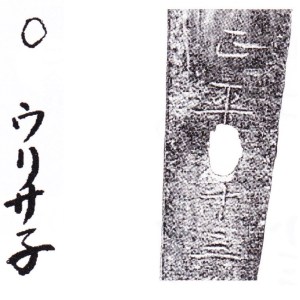
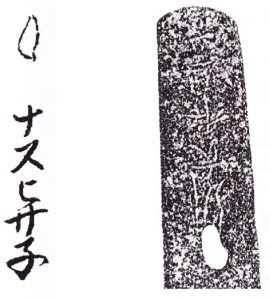

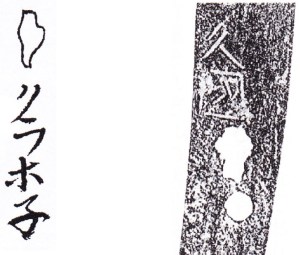




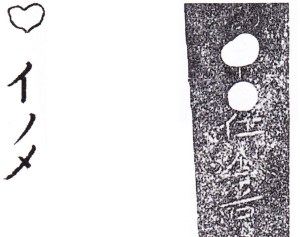
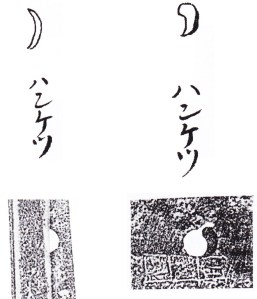
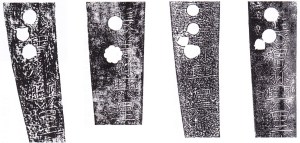

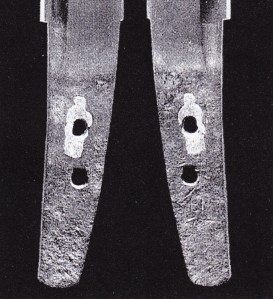
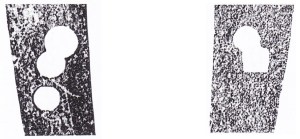
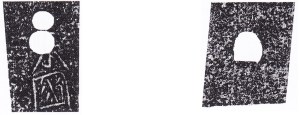

Thank you very much, great info.
Markus, many thanks for the interesting article.
A lot of good knowledge
Markus, Thanks for the article. Your article is the first I’ve found on mekugi-ana. I’m curious about the placement of mekugi-ana, relative to the mei. On shinto blades, most or all of the mei characters are usually below the mekugi-ana, but apparently that was not so in koto times. Was the relative position of mekugi-ana and mei on koto blades was completely random, or did it vary by smith, or by school?
Thanks again!
Dave Davis
Hi Dave, the relative position of the mekugi-ana and the mei did indeed vary from school to school and from smith to smith. That is, it was not completely random as each school usually had its own way to place the mei and more or less stuck to that but there is no rule that can be applied cross school-wise.
Wonderful information! Thank you!!!
Tjhis is invaluable information for collectors of any rank!
Pingback: Nakago: Examining the Tang of Japanese Swords - Swordis